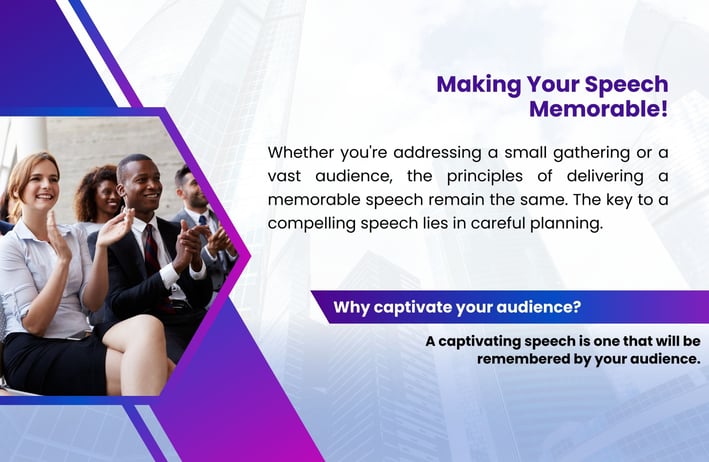Learn How to Create Memorable Presentations | Inspire Action
Discover effective delivery and audience engagement strategies for presenting to engage your audience, capture attention, and leave lasting impressions. Learn how to create memorable presentations ...
How to Give a Memorable Presentation
Introduction:
In public speaking, the difference between a forgettable presentation and a memorable one can define your success. Memorable presentations capture attention, inspire action, and leave lasting impressions. They require not only content that resonates but also effective delivery and audience engagement strategies. Whether you're presenting to a boardroom of executives, a classroom of students, or a conference full of peers, the principles of memorable public speaking are universal. This blog post will explore comprehensive strategies to ensure your next presentation not only delivers the intended message but does so in a way that your audience will remember long after you've left the podium.
Laying the Foundation for a Memorable Presentation
Understanding Your Audience
The first step in crafting a memorable presentation is to deeply understand who your audience is. Knowing your audience's demographics, interests, and knowledge level about the topic allows you to tailor your message effectively. For instance, a technical audience would appreciate jargon and detailed data, whereas a general audience might need simpler terms and more engaging stories. Conduct surveys, if possible, or review the profiles of expected attendees to shape your content and approach.
Setting Clear Objectives
Every memorable presentation has clear objectives. What do you want your audience to know, feel, or do after your presentation? Setting specific and measurable goals early in the preparation process will guide the development of your content and ensure that every element of your presentation is aligned with these goals. For example, if your goal is to persuade your audience to adopt a new software tool, every part of your presentation should support this persuasive objective.
Crafting a Compelling Message
Your central message is the core of your presentation. It should be concise, memorable, and impactful. Use a simple yet powerful statement that encapsulates your main idea and can be easily recalled by your audience. This message should echo throughout your presentation, reinforced by your arguments, stories, and visuals. For instance, if your message is about the importance of cybersecurity in modern businesses, each slide and story should tie back to this central theme, emphasizing its relevance and urgency.
By laying a solid foundation with a keen understanding of your audience, clear objectives, and a compelling message, you set the stage for a presentation that not only engages your audience but also leaves a lasting impact.
Designing Your Presentation for Maximum Impact
Storytelling Techniques
Storytelling is a powerful tool in public speaking that helps to make your presentation memorable. Stories can evoke emotions, simplify complex ideas, and make the abstract concrete. Incorporate personal stories, case studies, or hypothetical scenarios that relate directly to your key points. For example, if your presentation is about innovation, share a story about a famous inventor or a personal anecdote about a challenge overcome through creative thinking. Ensure your stories are relevant and serve to reinforce your central message.
Effective Use of Visual Aids
Visual aids, such as slides, charts, and videos, can enhance understanding and retention if used correctly. They should complement your words, not replace them. Keep slides uncluttered, use high-quality images, and ensure text is large enough to be read from the back of the room. For instance, use a graph to illustrate a significant trend instead of just talking about it, or show a short video clip that brings your points to life. Remember, each visual should serve a clear purpose.
Engaging Presentation Openings
The opening of your presentation sets the tone for everything that follows. Start with something that grabs attention—a startling statistic, a provocative question, or a compelling quote. The goal is to hook your audience from the beginning and make them eager to hear what comes next. For instance, if you are speaking about the importance of sustainability, you might begin with a surprising fact about global plastic use or an impactful quote from a renowned environmentalist.
Designing your presentation with these elements ensures that your delivery is not only informative but also engaging and memorable. Each component, from storytelling to visual aids, plays a crucial role in keeping your audience interested and making your message stick.
Mastering Delivery Techniques
Vocal Variety and Tone
The way you speak can greatly influence how your message is received. Using vocal variety—changes in pitch, pace, and volume—keeps your audience engaged and prevents monotony. For instance, lower your voice to draw people in for important points, and increase your volume to express enthusiasm or urgency. Practice varying your tone to match the emotional content of what you're discussing, which can make your presentation more dynamic and compelling.
Body Language and Non-Verbal Cues
Your body language speaks volumes about your confidence and enthusiasm. Use open gestures to convey openness and receptivity; move around the stage to engage different parts of the audience; and maintain good posture to project confidence. Be mindful of unintentional movements, such as fidgeting or crossing your arms, which can send signals of nervousness or defensiveness. Instead, channel nervous energy into positive gestures that complement your verbal message.
Handling Nerves and Building Confidence
It's quite natural to feel nervous before a presentation, but there are strategies to manage anxiety and project confidence. Preparation is key—know your material well so you can focus on delivery rather than remembering your lines. Techniques such as deep breathing or visualization can also help calm nerves. Before stepping onto the stage, take several deep breaths and visualize a successful presentation. Practice your speech multiple times in different settings and seek feedback to build confidence in your delivery.
Mastering these delivery techniques will not only improve how you present but also how your message is perceived and remembered. Effective use of voice, body language, and confidence-building measures can transform a good presentation into a memorable one, ensuring your audience leaves with a lasting impression of your message.
Interactive Elements to Engage the Audience
Incorporating Audience Participation
Engaging your audience directly can make your presentation more interactive and memorable. Techniques for audience participation include:
Questions and Answers: Pose questions to the audience during your presentation to stimulate thinking and interaction. This can be as simple as asking for a show of hands on a particular issue or inviting audience members to share their experiences related to your topic.
Live Polls: Use technology tools like live polling apps to gather instant feedback or opinions from the audience. This not only keeps the audience engaged but also makes your content more relevant to them in real-time.
Interactive Activities: Depending on the setting, include small group discussions or activities that allow audience members to apply the concepts you are discussing. This can be particularly effective in workshops or educational presentations.
Using Technology to Enhance Interaction
Technology can greatly enhance the interactivity of your presentation. Consider incorporating:
Audience Response Systems: Tools like Poll Everywhere or Slido allow audiences to participate in live polls, ask questions, or give feedback via their smartphones, which you can then display and discuss in real time.
Social Media Integration: Encourage live tweeting or posting about the presentation using a specific hashtag. This not only increases engagement but also extends the reach of your presentation beyond the physical room.
Virtual and Augmented Reality: For high-stakes presentations or when the budget allows, immersive experiences through VR or AR can make complex data or processes easier to understand and much more memorable.
By integrating these interactive elements, you can transform a passive listening experience into an active learning environment, making your presentation much more engaging and difficult to forget.
Rehearsing and Refining Your Presentation
Practice Makes Perfect
Rehearsing is critical to delivering a successful and memorable presentation. Here are effective methods to ensure your practice sessions are productive:
Simulated Environment: Try to practice in a setting similar to where you'll be presenting, whether it's a meeting room or on a stage. This helps you get comfortable with the space and manage any environmental factors.
Time Your Sessions: Keep track of how long your presentation takes during practice. This ensures that you stay within your allotted time during the actual event, allowing you to pace your content effectively.
Vary Your Practice Conditions: Practice under different conditions—such as with distractions, without your notes, or with a small audience. This prepares you for unexpected challenges and helps build confidence.
Seeking Constructive Feedback
Feedback from others can provide invaluable insights that refine your presentation:
Peer Review: Present in front of colleagues or friends and ask for specific feedback on both your content and delivery. Instruct them to note any unclear points or suggest areas for improvement.
Record and Review: Record your practice sessions and watch them back. This allows you to self-evaluate aspects like your body language, vocal delivery, and use of visual aids.
Professional Coaching: If possible, consider working with a professional speech coach who can provide expert guidance and help hone your presentation skills to a higher standard.
Feedback and continuous practice are indispensable for identifying areas that need improvement and for fine-tuning your delivery to ensure clarity, engagement, and memorability.
Essential Tips for Presentation Day
On the day of your presentation, it’s crucial to be fully prepared to execute all that you’ve practiced:
Final Preparation Tips: Arrive early to check the setup, test technical equipment, and get comfortable with the surroundings. Ensure all your materials, such as handouts or additional equipment, are ready and accessible.
Dealing with Unexpected Issues: Stay adaptable and calm. If technical issues arise or if you're thrown an unexpected question, use the skills you've honed during practice to handle these smoothly. Keeping a backup of your presentation on multiple devices or a printed copy can save you from technical malfunctions.
This thorough preparation and rehearsal process not only boosts your confidence but also ensures you are well-equipped to deliver a polished and memorable presentation.
Evaluating Your Presentation’s Success
Measuring Audience Engagement
To assess the effectiveness and memorability of your presentation, you need to measure how well it engaged your audience. Here are some strategies to consider:
Feedback Forms: Distribute feedback forms or surveys to the audience immediately after the presentation. Ask specific questions about what they learned, what they found most interesting, and any areas for improvement.
Observation: Pay attention to audience reactions during the presentation. Were they attentive and responsive? Did they participate during interactive segments? Noting these behaviors can give you insights into the presentation's impact.
Follow-Up: If applicable, follow up with attendees via email to provide additional resources related to your presentation. This can also be an opportunity to ask for feedback if you didn’t collect it immediately after the event.
Learning from Each Experience
Every presentation is an opportunity to learn and refine your skills. Reflect on your performance and gather all feedback to identify key takeaways:
Self-Reflection: After your presentation, take some time to reflect on what went well and what didn’t. Consider how your preparation affected your performance and think about adjustments for future presentations.
Constructive Criticism: Embrace constructive criticism and use it to focus on specific areas for improvement. If feedback is consistently pointing to a particular issue, such as rushing through your material or unclear explanations, prioritize these areas in your practice sessions.
Continuous Improvement: Set goals for future presentations based on your experiences and feedback. Continuous improvement will help you grow as a speaker and ensure that each presentation is more effective than the last.
Evaluating your presentation's success is crucial for ongoing development. By actively seeking and learning from feedback, you can continue to enhance your public speaking skills and increase the memorability of your presentations.
Conclusion:
Creating and delivering a memorable presentation requires careful preparation, engaging delivery, and active engagement strategies. By understanding your audience, refining your message, and effectively using visual and interactive elements, you can significantly increase the impact of your presentations. Remember, the most memorable presentations are those that connect with the audience on an emotional level and leave them with actionable insights. Continue to seek feedback and strive for improvement with each speaking opportunity.




© 2024 The Confident Orator. All rights reserved.


